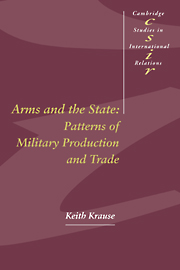Book contents
- Frontmatter
- Contents
- List of figures
- List of tables
- Acknowledgements
- Introduction
- 1 Motive forces in the evolution of the arms transfer and production system
- 2 The emergence of a global arms transfer and production system
- 3 From the Military Revolution to the Industrial Revolution
- 4 An overview of the post-1945 global arms transfer system
- 5 The dominance of first-tier producers and suppliers
- 6 Second-tier producers and suppliers: the struggle to keep pace
- 7 Dependent production and exports in the third tier
- 8 The subordinate role of arms recipients
- Conclusion
- Appendix: Arms transfer data sources and problems
- Notes
- Bibliography
- Index
Conclusion
Published online by Cambridge University Press: 22 September 2009
- Frontmatter
- Contents
- List of figures
- List of tables
- Acknowledgements
- Introduction
- 1 Motive forces in the evolution of the arms transfer and production system
- 2 The emergence of a global arms transfer and production system
- 3 From the Military Revolution to the Industrial Revolution
- 4 An overview of the post-1945 global arms transfer system
- 5 The dominance of first-tier producers and suppliers
- 6 Second-tier producers and suppliers: the struggle to keep pace
- 7 Dependent production and exports in the third tier
- 8 The subordinate role of arms recipients
- Conclusion
- Appendix: Arms transfer data sources and problems
- Notes
- Bibliography
- Index
Summary
As Stephanie Neuman and Robert Harkavy point out, ‘for the most part the arms transfer literature has confined itself to asking and answering descriptive questions about who is buying what from whom for how much and how this affects the U.S.–USSR balance. Only recently has the world's attention been drawn to the … complex interrelationships between arms transfers and developments within and among nations.’ This book has focused on the latter set of complex relationships at the general or systemic level in order to provide a better understanding of arms transfers as a phenomenon of international relations and to reduce the conceptual chaos that is often found in the literature. The intent was not to develop a rigorous ‘theory’ or ‘model’ of the global arms transfer and production system, but rather to provide a framework within which diverse phenomena can be better explained. Thus instead of embarking on a detailed and purely descriptive study of a particular aspect of the arms transfer system, the book cast its net more widely to answer such questions as: ‘What are the constituent elements of an arms transfer “system”?’ ‘What motives govern states' participation in arms transfers?’ and ‘What are the implications of these factors for the emergence and evolution of the system?’
Existing analyses of the arms trade, although often well documented and informative, also generally lack the historical perspective required for this task.
- Type
- Chapter
- Information
- Arms and the StatePatterns of Military Production and Trade, pp. 205 - 215Publisher: Cambridge University PressPrint publication year: 1992

